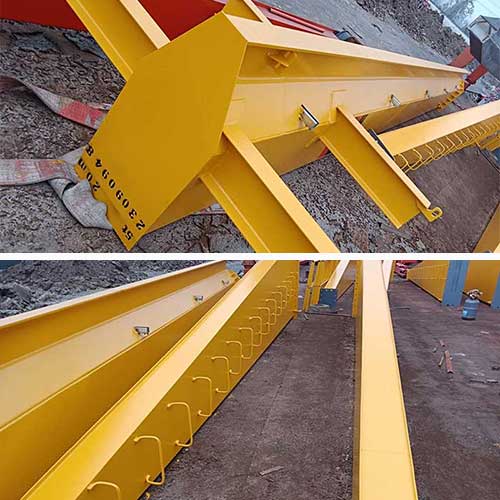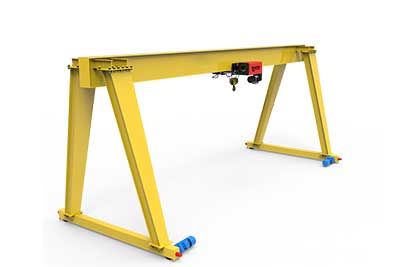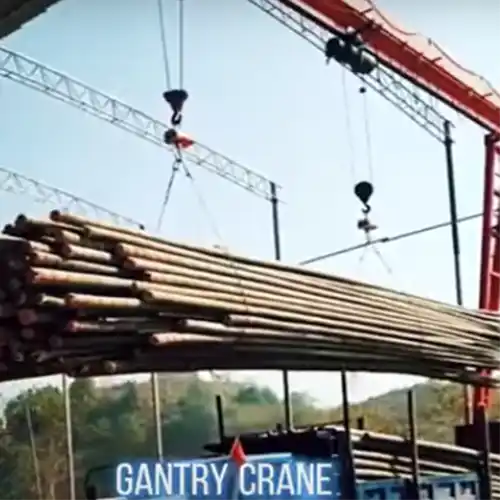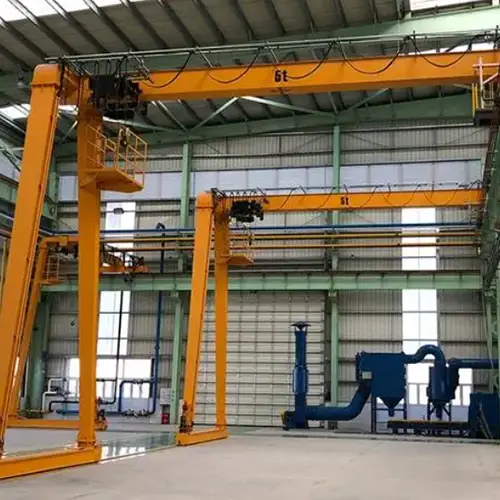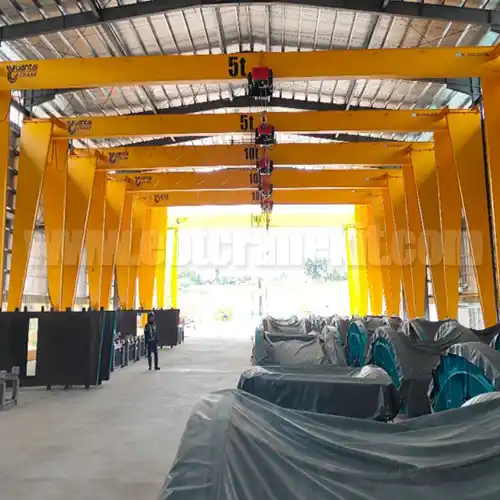5 Ton Gantry Cranes for Sale Zimbabwe & Cost-Benefit Analysis
5 ton gantry cranes for sale Zimbabwe. 5 ton single girder gantry crane project case study & crane cost-benefit analysis for you to get best price crane.
| Crane type | single girder gantry crane |
| Crane capacity | 5 ton |
| Lifting Height | 6 m |
| Crane Span | 30m |
| Project location | Zimbabwe |
Category: 5 Ton Gantry Crane
Your Trusted 5 Ton Gantry Crane Manufacturer & Supplier
5 Ton Gantry Cranes for Sale Zimbabwe & Cost-Benefit Analysis
5 ton gantry cranes for sale Zimbabwe. 5 ton single girder gantry crane project case study & crane cost-benefit analysis for you to get best price crane.
Case Study: Enhancing Material Handling Efficiency with 5-Ton Gantry Cranes in Zimbabwe
Zimbabwe, a nation with a burgeoning industrial sector, has been experiencing an increased demand for efficient material handling equipment. In response to this growing need, a local manufacturing company sought to optimize its material handling capabilities by integrating advanced gantry crane technology into its operations. This case study highlights the successful deployment of two 5-ton gantry cranes, featuring single girder design and Chinese-style electric wire rope hoists, in Zimbabwe.
Project Details:
Client: A leading manufacturing company in Zimbabwe
Project Location: Zimbabwe
Crane Types: Single girder gantry crane with electric wire rope hoists
Crane Specifications:
Capacity: 5 tons
Span: 20 meters
Lifting Height: 6 meters
Crane Power Supply: 380V, 50Hz, 3-phase
Quantity: 2 sets
Project Objectives:
The client aimed to enhance material handling efficiency and overall productivity in their manufacturing facility by implementing reliable and robust gantry cranes. The key objectives were:
1. Streamline material movement within the facility, minimizing manual handling and reducing the risk of accidents.
2. Increase productivity by reducing downtime associated with inefficient material handling.
3. Improve safety standards and comply with industry regulations.
4. Enhance the versatility and flexibility of material handling within the facility.
Challenges:
Prior to the installation of the gantry cranes, the client faced several challenges:
1. Manual material handling was labor-intensive and often resulted in operational delays.
2. Safety concerns were paramount due to the potential for workplace accidents.
3. Existing equipment did not meet the increasing demands of the facility's production.
Solution:
The client decided to invest in two 5-ton gantry cranes, each featuring a single girder design with Chinese-style electric wire rope hoists. The decision to opt for this configuration was based on its compatibility with their manufacturing processes and the expected benefits of enhanced reliability, safety, and efficiency.
Benefits:
The implementation of the 5-ton gantry cranes delivered several notable benefits:
- 1. Enhanced Efficiency: The gantry cranes facilitated swift and precise material handling, reducing production bottlenecks and enhancing overall efficiency.
- 2. Safety Improvements: The client observed a significant reduction in workplace accidents and injuries, owing to the gantry cranes' precise control and operator-friendly design.
- 3. Improved Productivity: The cranes minimized downtime caused by inefficient material handling, enabling the company to meet production targets more consistently.
- 4. Adaptability: The versatility of the gantry cranes allowed for the handling of various loads, contributing to the client's ability to adapt to changing production requirements.
- 5. Compliance: The new equipment met industry regulations and standards, ensuring a safe and compliant workplace.
Main Parts and Components of 5 Ton Gantry Crane for SaleZimbabwe

Main girder of 5 ton single girder gantry crane for sale Zimbabwe
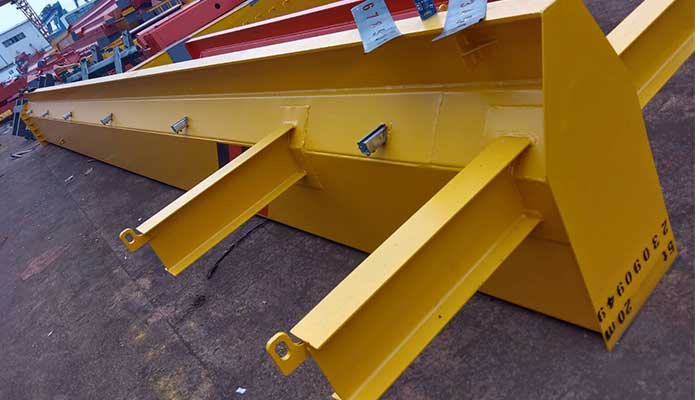
5 ton gantry crane main girder for Zimbabwe project
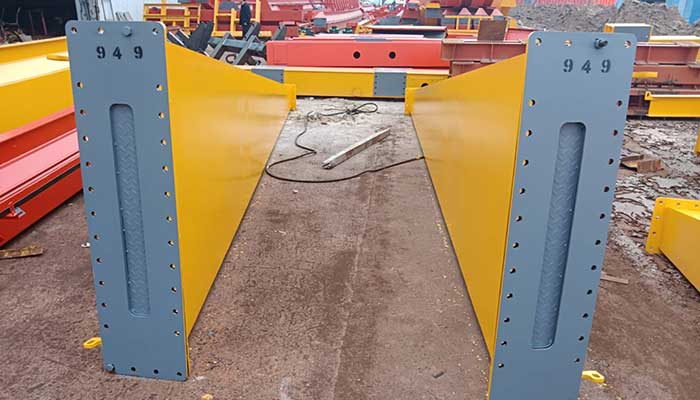
Supporting legs of 5 ton gantry crane with single girder and rail travelling gantry crane design
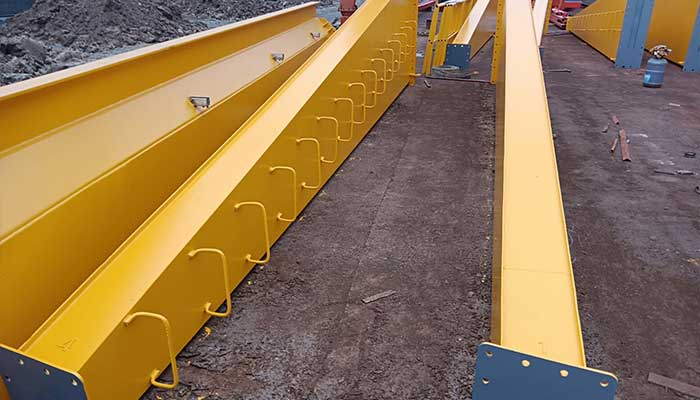
Main parts and components of single girder gantry crane 5 ton

5 ton gantry crane hoist
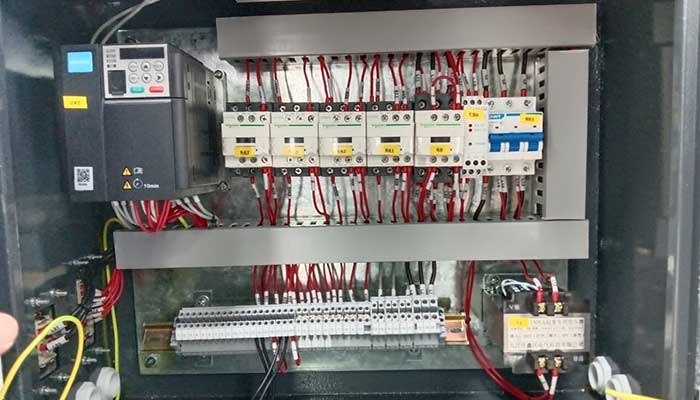
Electricals of 5 ton gantry crane hoist
The deployment of two 5-ton gantry cranes with Chinese-style electric wire rope hoists in Zimbabwe proved to be a game-changer for the manufacturing company. The cranes enhanced material handling efficiency, reduced safety concerns, and significantly improved productivity. By aligning their objectives with advanced material handling technology, the client successfully optimized their manufacturing operations, positioning themselves for future growth and success in an increasingly competitive market.
Cost-Benefit Analysis: Conduct a detailed cost-benefit analysis to assess the financial impact of the gantry crane installation.
Consider the initial investment, operational costs, and the savings or revenue generated through increased productivity and safety improvements.
Background on the Sale of 5-Ton Gantry Cranes in Zimbabwe
In the heart of Southern Africa, Zimbabwe's industrial landscape is undergoing a remarkable transformation. With the nation's manufacturing sector on the rise, the demand for efficient material handling equipment has never been more pronounced. It's against this backdrop that a local manufacturing company embarked on a bold initiative – the sale of 5-ton gantry cranes equipped with single girder designs and Chinese-style electric wire rope hoists. This endeavor stands as a pivotal moment in Zimbabwe's industrial journey, representing a significant step forward in the evolution of material handling technology within the nation.
Purpose of the Cost-Benefit Analysis
The purpose of this article is to delve into the financial implications of this remarkable venture – the sale of 5-ton gantry cranes in Zimbabwe. It is within the domain of a comprehensive cost-benefit analysis that we endeavor to unravel the intricacies of this economic watershed. This analysis aims to provide an illuminating view of the financial viability of introducing advanced material handling solutions into the Zimbabwean industrial landscape. In doing so, it will not only serve the immediate stakeholders of the manufacturing company but will also offer invaluable insights to businesses and industries contemplating similar advancements in their operational paradigms.
Overview of Key Financial Considerations
Initial Investment: The financial commitment required to acquire these 5-ton gantry cranes takes center stage. This encompasses not only the direct cost of the cranes themselves but also supplementary expenses relating to installation, transportation, and setup. The acquisition of these gantry cranes marks a significant capital outlay. To break this down further:
Direct Costs: This includes the base price of the gantry cranes and any optional features or customization.
Installation Expenses: Skilled labor and equipment are needed for the assembly and configuration of the cranes.
Transportation Costs: The logistical challenge of moving the gantry cranes to their destination adds another layer of expense.
Setup Costs: The final step in making the gantry cranes operational involves not only physical assembly but also calibration, testing, and alignment.
Financing Options: We will explore whether any financing options were availed, such as bank loans or leasing arrangements, and their terms and interest rates. This dimension of the analysis is crucial in understanding the upfront and ongoing financial commitment.
Operational Costs: The financial journey doesn't conclude at the point of acquisition; it unfolds with the day-to-day operations. We will scrutinize the routine costs of maintenance and repair, energy consumption, operator salaries, and training, along with ongoing operational expenses, including insurance. These are the ongoing financial responsibilities tied to the operation of the gantry cranes.
Productivity Improvements: The performance of these advanced gantry cranes plays a pivotal role in our analysis. We will quantify the upswing in material handling efficiency and assess the consequential reduction in downtime. This aspect is crucial as it directly influences the bottom line and overall operational performance. We will delve into:
Efficiency Metrics: Specific efficiency metrics that have improved due to the gantry cranes.
Comparison Before and After: How material handling processes have changed.
Reduction in Downtime: The impact on operational downtime, which can be a significant financial drain.
Production Output Metrics: The increase in production output in terms of units produced or orders fulfilled.
Revenue Impact: How increased production output has influenced additional revenue and potential cost reductions through economies of scale.
Safety Improvements: In the era of stringent safety regulations, the aspect of workplace safety is paramount. Our analysis will delve into the reduction of workplace accidents and incidents, allowing us to estimate the associated cost savings and exploring potential reductions in insurance premiums. We will look into:
Accident and Incident Metrics: The number of workplace accidents, near misses, and incidents related to material handling.
Comparative Analysis: Comparing safety records before and after the introduction of the gantry cranes.
Cost of Injuries and Damage: The direct and indirect costs associated with workplace injuries and equipment damage.
Potential Reduction in Insurance Premiums: The direct financial benefit resulting from enhanced safety measures.
Revenue Generation: The introduction of these gantry cranes has the potential to be more than a cost-saving endeavor. We will carefully examine whether these equipment have opened doors to new business opportunities, measure the increased customer satisfaction and repeat business, and explore whether they have paved the way for diversification or market expansion.
Timeframe for Analysis: A critical dimension of our assessment is the timeframe within which the cost-benefit analysis will be conducted. Will the analysis focus on short-term or long-term impacts? We will define the time horizon, which will significantly influence the financial outcome we present.
By comprehensively considering these key financial considerations, our study into the cost-benefit analysis of introducing 5-ton gantry cranes in Zimbabwe is set to be insightful and revealing. The insights gleaned from this analysis will not only illuminate the path for the manufacturing company but also have far-reaching implications for the employees, the local business community, and the broader industrial landscape of Zimbabwe.
Initial Investment
Breakdown of the Cost of Each 5-Ton Gantry Crane
Let's start by studying the initial investment required for the acquisition of each 5-ton gantry crane. This involves a complex examination of the direct costs associated with the cranes themselves. These robust material handling machines are not just functional; they represent a significant capital outlay.
- 1. Base Price of the Gantry Cranes: At the heart of our financial exploration lies the core cost of the 5-ton gantry cranes. We will dissect the base price, considering the make, model, and any standard features included in the acquisition.
- 2. Customization and Optional Components: In the world of heavy machinery, customization is often a necessity to tailor the equipment to the unique needs of the business. We will scrutinize any additional features, customization options, or optional components that were included in the purchase. This customization may influence both the initial investment and long-term operational efficiency.
- 3. Maintenance Packages and Warranties: A comprehensive analysis should also take into account whether any maintenance packages or warranties were bundled with the acquisition. These could impact the overall cost over the lifetime of the cranes and offer protection against unexpected repair expenses.
Additional Expenses Such as Installation, Transportation, and Setup
Beyond the acquisition costs, it is imperative to recognize that the process doesn't conclude with the crane purchase itself. The installation, transportation, and setup of these heavy-duty machines add an additional layer of expenses that should not be overlooked.
- 1. Installation Costs: The process of erecting and configuring these gantry cranes is a specialized task that demands skilled labor and equipment. This may involve the assembly of steel structures, attachment of electrical components, and the fine-tuning of operational parameters. An analysis of the installation expenses will factor prominently in our assessment, considering both labor and equipment costs.
- 2. Transportation Expenses: The logistical challenges of moving the gantry cranes from the point of purchase to their destination are non-trivial. The transportation expenses can be influenced by factors such as distance, accessibility, and handling requirements. These costs play a vital role in determining the overall financial impact of the venture. We will consider the logistics of transportation, including the modes of transport used.
- 3. Setup Costs: The final step in making these gantry cranes operational is setup. This encompasses not only physical assembly but also calibration, testing, and alignment. These tasks necessitate time, labor, and equipment, each with its associated cost.
Financing Options, If Applicable
The question of financing options cannot be disregarded in our examination. In the realm of significant capital investments, businesses often explore avenues to distribute the financial burden over time. Financing options might include bank loans, leasing arrangements, or other credit facilities that enable the acquisition of these gantry cranes while spreading the cost over a period.
- 1. Types of Financing: We will explore whether the manufacturing company availed any financing options and detail the specific types used, such as bank loans, leases, or other financial instruments.
- 2. Terms and Interest Rates: Understanding the terms of the financing options is essential. We will delve into the interest rates, repayment periods, and any collateral or guarantees that may have been required.
By scrutinizing the initial investment, including the detailed cost breakdown of each gantry crane, the expenses related to installation, transportation, and setup, and the financial considerations tied to financing options, we will be equipped with a firm understanding of the economic landscape at the outset of this groundbreaking venture. These insights will pave the way for a more comprehensive and nuanced cost-benefit analysis, helping us assess the true financial implications of introducing 5-ton gantry cranes in Zimbabwe.
Operational Costs
Routine Maintenance and Repair Expenses
Having looked into the initial investment, we now navigate further into the section of operational costs. In this section, we will explore the financial part associated with the routine maintenance and repair of the 5-ton gantry cranes. These costs represent the ongoing commitment to keeping these vital material handling assets in prime working condition.
Routine Maintenance: Maintenance is the lifeblood that sustains the functionality and longevity of any equipment. Our examination of routine maintenance expenses will encompass the following aspects:
Scheduled Inspections: Regular inspections to identify wear and tear, potential issues, and the need for preventive maintenance.
Lubrication: The cost of lubricants and maintenance materials to ensure smooth operation.
Parts Replacement: Expenses related to the replacement of components that naturally degrade over time.
Maintenance Personnel: Salaries and compensation for maintenance personnel responsible for keeping the gantry cranes in optimal condition.
Repair Expenses: In the event of mechanical breakdowns or wear and tear, repair expenses come into play. Our analysis of repair expenses will cover the following:
Replacement Parts: The cost of acquiring and installing replacement parts for the gantry cranes.
Skilled Labor: Expenses related to hiring skilled technicians to carry out repairs efficiently and effectively.
Downtime Costs: Any financial impact caused by downtime during the repair process, which may include the cost of delayed production or missed orders.
Energy Consumption and Associated Costs
Energy consumption is a significant operational cost that merits careful consideration. These gantry cranes rely on power to function, and the electricity required for their operation has financial implications.
Energy Costs: Our analysis will examine the energy consumption of the gantry cranes and calculate the associated electricity costs. This will encompass:
Energy Consumption Metrics: Detailed data on the energy consumption patterns of the gantry cranes.
Electricity Rates: The cost per unit of electricity, which can vary based on time of use (peak vs. off-peak) and location.
Energy-Saving Technologies: Exploration of any technologies or features incorporated into the cranes that may reduce energy consumption and associated costs.
Operator Salaries and Training
The human element is a vital cog in the operational machinery. The performance of these gantry cranes relies on skilled operators, and the salaries of these individuals are an operational expense. Additionally, the training of operators is essential to ensure safe and efficient crane operation.
- 1. Operator Salaries: Our analysis will examine the financial commitments related to operator salaries, including:
Regular Wages: The base salaries of crane operators.
Additional Compensation or Incentives: Any bonuses, overtime pay, or other financial incentives offered to operators based on performance or other factors. - 2. Operator Training: Training programs for crane operators represent a crucial aspect of operational costs. Our examination will consider the following:
Initial Training Expenses: The costs associated with training new operators to ensure they can safely and effectively operate the gantry cranes.
Ongoing Training Costs: Expenses related to continuous skill development and safety training for operators to maintain proficiency and adhere to best practices.
Insurance and Other Ongoing Expenses
The commitment to operational excellence encompasses various ongoing expenses that deserve scrutiny.
Insurance: Workplace safety is paramount, and insurance is a critical component of maintaining a secure work environment. Our analysis will evaluate the costs associated with insurance coverage, which includes:
Coverage Types: An exploration of the types of insurance policies held, such as liability insurance or equipment insurance.
Insurance Premiums: The recurring expenses for insurance coverage.
Claims History: A review of past claims, if any, and their impact on premiums.
Other Ongoing Expenses: This category will encompass miscellaneous ongoing operational expenses, which may include:
Regulatory Compliance Costs: Expenses related to adhering to safety and industry regulations.
Safety Measures: Costs associated with safety equipment and measures to maintain a secure work environment.
Unforeseen Expenses: An examination of any unforeseen operational costs that may arise during the operation of the gantry cranes.
By dissecting these operational costs, from routine maintenance and repair expenses to energy consumption and associated costs, operator salaries and training, and insurance, we aim to provide a holistic view of the financial responsibilities tied to the operation of 5-ton gantry cranes. These insights will inform our comprehensive cost-benefit analysis, illuminating the financial impact of this venture in Zimbabwe's industrial landscape.
Insurance and Other Ongoing Expenses
The commitment to operational excellence encompasses various ongoing expenses that deserve scrutiny.
Insurance: Workplace safety is paramount, and insurance is a critical component of maintaining a secure work environment. Our analysis will evaluate the costs associated with insurance coverage, which includes:
Coverage Types: An exploration of the types of insurance policies held, such as liability insurance, equipment insurance, workers' compensation, and general liability.
Insurance Premiums: The recurring expenses for insurance coverage, including any monthly, quarterly, or annual premiums.
Claims History: A review of past claims, if any, and their impact on premiums, deductibles, and the overall cost of insurance.
Other Ongoing Expenses: This category will encompass miscellaneous ongoing operational expenses, such as:
Regulatory Compliance Costs: Expenses related to adhering to safety and industry regulations, including permits, inspections, and compliance reporting.
Safety Measures: Costs associated with safety equipment, measures, and training programs that help maintain a secure work environment and reduce the risk of accidents.
Unforeseen Expenses: An examination of any unforeseen operational costs that may arise during the operation of the gantry cranes, including emergency repairs, unexpected maintenance, or unforeseen compliance costs.
By dissecting these operational costs, from routine maintenance and repair expenses to energy consumption and associated costs, operator salaries and training, and insurance, we aim to provide a holistic view of the financial responsibilities tied to the operation of 5-ton gantry cranes. These insights will inform our comprehensive cost-benefit analysis, illuminating the financial impact of this venture in Zimbabwe's industrial landscape.
Productivity Improvements
Maximizing Efficiency and Boosting the Bottom Line: The Financial Impact of 5-Ton Gantry Cranes in Zimbabwe
In a bid to strengthen their industrial capabilities, a manufacturing company in Zimbabwe made a significant investment by introducing 5-ton gantry cranes into their operations. The decision was not just about acquiring state-of-the-art material handling equipment; it was a strategic move to enhance efficiency, reduce operational downtime, and ultimately improve their financial performance. In this blog, we embark on a detailed exploration of the financial impact of these gantry cranes, focusing on the productivity improvements they have ushered in.
Measure the Increase in Material Handling Efficiency
One of the central benefits of introducing 5-ton gantry cranes into Zimbabwe's industrial landscape is the potential for significant enhancements in material handling efficiency. In this section, we will quantify and analyze the increase in material handling efficiency, which directly influences the bottom line and overall operational performance.
- Efficiency Metrics: The journey begins by scrutinizing the specific efficiency metrics that have improved due to the gantry cranes. These could include measures such as the time required to load and unload materials, the number of daily handling operations, and the reduction in manual handling. These metrics will serve as the foundation for our financial analysis.
- Comparison Before and After: By comparing the material handling processes before and after the introduction of the gantry cranes, we can quantify the efficiency gains and their financial implications. The reduction in man-hours and the increased handling capacity will be carefully considered.
Assess the Reduction in Downtime
Operational downtime can be a significant financial drain on any manufacturing facility. These gantry cranes have the potential to significantly reduce downtime, leading to more streamlined and cost-effective operations.
- Downtime Metrics: To assess the financial impact of reduced downtime, we will delve into specific metrics that measure the reduction, including the frequency and duration of unplanned equipment breakdowns and maintenance-related stoppages. Understanding how these metrics have improved is essential to our analysis.
- Cost of Downtime: By estimating the cost of downtime, including lost production, idle labor, and potential penalties for order delays, we can gauge the financial impact of reduced downtime. The tangible cost savings will be a significant component of our assessment.
Evaluate Any Improvement in Production Output
An increase in production output is a clear indicator of improved operational efficiency. In this segment, we will evaluate the impact of the gantry cranes on the manufacturing company's production output and assess its financial implications.
- Production Output Metrics: Our analysis will quantify the increase in production output in terms of units produced, orders fulfilled, or any other relevant productivity metrics. We will investigate how these metrics have evolved in response to the introduction of gantry cranes.
- Revenue Impact: By exploring the financial impact of increased production output, including the additional revenue generated and the potential for cost reductions through economies of scale, we will illustrate how enhanced production ties directly to financial performance.
Consider the Impact on Lead Times and Order Fulfillment
Lead times and order fulfillment are crucial aspects of operational efficiency in manufacturing. The gantry cranes have the potential to impact these factors, thereby influencing customer satisfaction and competitiveness.
- Lead Time Reduction: We will analyze the reduction in lead times, from order placement to delivery, and assess how this has affected the company's ability to meet customer expectations. Shorter lead times can lead to a more competitive position in the market.
- Customer Satisfaction and Repeat Business: The ability to fulfill orders more promptly can lead to improved customer satisfaction and repeat business. We will investigate how these operational improvements influence the company's financial performance by contributing to customer loyalty and repeat orders.
By looking into the productivity improvements brought about by the 5-ton gantry cranes, we aim to provide a comprehensive understanding of how these machines have enhanced the manufacturing company's efficiency, competitiveness, and financial performance. These insights will play a pivotal role in our overall cost-benefit analysis, offering a clearer view of the financial impact of these technological advancements in Zimbabwe's industrial landscape.
In our next installment, we will explore the safety improvements ushered in by the gantry cranes, offering insights into the potential cost savings associated with reduced workplace incidents and the advantages of a safer working environment. Stay tuned as we continue our financial journey into the impact of these powerful machines.
Revenue Generation: The Financial Impact of 5-Ton Gantry Cranes
Beyond the significant operational and efficiency improvements brought about by the introduction of 5-ton gantry cranes in Zimbabwe's industrial landscape, these powerful machines have the potential to open the door to new revenue streams and enhanced customer satisfaction. In this section, we will delve into the financial implications of revenue generation, which is a direct result of these advanced material handling solutions.
Assess Whether the Gantry Cranes Have Facilitated New Business Opportunities
The introduction of 5-ton gantry cranes can extend beyond the realm of cost reduction and operational efficiency; it can also open doors to new business opportunities. In this section, we will assess whether the gantry cranes have facilitated new business opportunities for the manufacturing company.
- New Business Ventures: To measure the financial impact, we will examine whether the company has ventured into new areas of business or secured contracts that were previously unattainable without the advanced material handling capabilities provided by the gantry cranes. These new ventures can bring in additional revenue streams.
- Market Expansion: By assessing any expansions into new markets or industries, we can quantify the extent to which the gantry cranes have broadened the company's revenue streams. Entering new markets can result in an increased customer base and higher revenues.
Measure the Increase in Customer Satisfaction and Repeat Business
Customer satisfaction and loyalty are crucial for sustained growth and profitability. The efficiency and reliability of the gantry cranes can have a direct impact on these factors. In this part, we will measure the increase in customer satisfaction and its correlation with repeat business.
- Customer Feedback: To gauge the financial impact of improved customer satisfaction, we will collect and analyze feedback from the company's customers. This feedback will provide insights into their experience, including satisfaction with lead times, order fulfillment, and service quality. Satisfied customers are more likely to continue doing business with the company.
- Repeat Business Metrics: By assessing the rate of repeat business and the number of loyal customers, we can quantify the increase in customer satisfaction and its influence on revenue through repeat orders. Higher customer retention and a larger pool of loyal customers contribute directly to increased revenue.
Explore Whether the Equipment Has Allowed for Diversification or Market Expansion
One of the potential benefits of advanced material handling equipment is its ability to facilitate diversification and market expansion. In this section, we will explore whether the gantry cranes have allowed the manufacturing company to diversify its product offerings or expand into new markets.
- Product Diversification: By exploring whether the company has introduced new products or services enabled by the gantry cranes, we can quantify the financial impact of diversification. Handling larger or more diverse types of materials or products can lead to revenue growth.
- Market Expansion: Assessing any geographical or market expansion will help us quantify the impact of the gantry cranes on the company's ability to reach new customers and achieve a broader market presence. Entering new markets or expanding geographically can significantly increase revenue opportunities.
By evaluating the potential for revenue generation resulting from the introduction of 5-ton gantry cranes, including the facilitation of new business opportunities, improved customer satisfaction and repeat business, and the potential for diversification or market expansion, we aim to provide insights into how these advanced material handling solutions have contributed to the company's revenue growth and overall financial performance. These insights will be instrumental in our comprehensive cost-benefit analysis, offering a well-rounded view of the financial impact of introducing these advanced technological solutions in Zimbabwe.
In our next blog installment, we will explore the timeframe for our cost-benefit analysis, defining the period over which we will assess the financial impact and highlighting any short-term vs. long-term considerations. Stay with us as we continue to uncover the financial landscape of these powerful gantry cranes.
Timeframe for Analysis: Unveiling the Temporal Dimensions of Financial Impact
To accurately assess the financial implications of introducing 5-ton gantry cranes into Zimbabwe's industrial landscape, we must meticulously consider the temporal scope of our cost-benefit analysis. The timeframe selected plays a pivotal role in determining when and how the financial impact materializes. In this section, we delve into the critical dimensions of the analysis timeframe, and we'll highlight the distinction between short-term and long-term financial impacts.
Highlight Any Short-Term vs. Long-Term Financial Impacts
- Short-Term Considerations: We will explore financial outcomes that become evident within the initial phase of our analysis. This includes upfront investments, immediate cost reductions, and immediate safety improvements. Understanding these short-term consequences provides insights into the initial financial challenges and rewards of implementing the gantry cranes.
- Long-Term Considerations: We will explore financial changes that emerge over several years, including cumulative cost savings, productivity improvements, customer loyalty, repeat business, and the realization of long-term business opportunities facilitated by the gantry cranes. Understanding these long-term financial impacts allows us to paint a comprehensive picture of the economic implications of these advanced material handling solutions.
Understanding the temporal dynamics of our cost-benefit analysis is not only essential but also enlightening. It allows us to distinguish between the immediate financial outcomes and those that become more apparent over an extended period. This nuanced perspective is crucial in providing a comprehensive view of the economic impact of introducing 5-ton gantry cranes in Zimbabwe. In our next blog installment, we will dive deep into quantitative data, collecting and analyzing numbers to support our financial assessment. Stay with us as we continue to unravel the financial impact of these powerful machines.
Quantitative Data
Collect Quantitative Data Related to All Cost and Benefit Categories
To ensure the accuracy and rigor of our cost-benefit analysis, it is imperative to gather quantitative data pertaining to all cost and benefit categories. In this section, we will outline the process of data collection, encompassing both financial costs and gains.
- 1. Data Collection Plan: We will define a structured plan for collecting quantitative data related to the identified cost categories, including initial investment, operational costs, productivity improvements, safety improvements, and revenue generation. This plan should involve financial statements, expense reports, safety records, and customer feedback data.
- 2. Quantitative Metrics: For each cost and benefit category, we will identify specific quantitative metrics that allow us to measure and analyze financial changes accurately. These metrics may include expenses in local currency, revenue figures, accident rates, energy consumption data, production output numbers, and customer satisfaction ratings.
- 3. Data Sources: We will identify the sources from which data will be collected, including company financial records, safety reports, operational logs, and customer surveys. Ensuring the reliability and integrity of these data sources is paramount.
Create Financial Models and Projections
Financial models and projections are fundamental tools in a cost-benefit analysis, aiding in the quantification of potential outcomes. In this section, we will discuss the creation of financial models and projections to evaluate the long-term financial impact of the gantry crane implementation.
- 1. Financial Modeling Techniques: We will determine the financial modeling techniques to be employed. This could encompass methods such as Net Present Value (NPV), Return on Investment (ROI), or Cost-Benefit Ratio (CBR).
- 2. Input Data Integration: We will integrate the quantitative data collected into the financial models, ensuring that the inputs are accurate, consistent, and aligned with the identified cost and benefit categories.
- 3. Scenario Analysis: Financial projections may involve scenario analysis, examining multiple potential outcomes based on different assumptions. This approach provides a range of possible financial scenarios, allowing for a more comprehensive evaluation.
- 4. Sensitivity Analysis: To account for uncertainties and variable factors, we may conduct sensitivity analysis, testing how changes in key variables impact the financial results. This will help identify potential risks and opportunities.
- 5. Presentation of Projections: The results of the financial models and projections will be presented in a clear and understandable format, highlighting the expected financial outcomes over the defined timeframe.
By collecting quantitative data and creating financial models and projections, we ensure that our cost-benefit analysis is rooted in concrete data and provides a reliable basis for assessing the financial implications of the gantry crane implementation in Zimbabwe. These quantitative insights will be essential in guiding our assessment and drawing well-informed conclusions about the venture's financial impact.
Qualitative Data
Gather Qualitative Insights from Employees, Operators, and Management
While quantitative data is crucial for a cost-benefit analysis, qualitative insights are equally valuable in providing a well-rounded understanding of the impact of 5-ton gantry cranes in Zimbabwe. In this section, we will outline the process of gathering qualitative feedback from employees, operators, and management.
- 1. Interviews and Surveys: We will organize interviews, surveys, or focus group discussions with employees, crane operators, and management to capture their experiences, perspectives, and observations regarding the gantry crane implementation.
- 2. Open-Ended Questions: Qualitative data collection will include open-ended questions that encourage participants to provide detailed and candid feedback. Questions may relate to safety, operational efficiency, job satisfaction, and any unforeseen challenges or opportunities.
- 3. Anonymity and Confidentiality: To ensure honest and open feedback, we will assure participants of the anonymity and confidentiality of their responses, creating a safe space for sharing insights.
Consider Feedback on Safety, Operational Efficiency, and Overall Satisfaction
The qualitative data gathered from employees, operators, and management will provide rich insights into safety, operational efficiency, and overall satisfaction. In this part, we will outline the process of analyzing and considering this feedback.
- 1. Safety Insights: We will categorize and analyze feedback related to safety, paying particular attention to any identified safety improvements, near misses, and suggestions for further enhancements.
- 2. Operational Efficiency Feedback: The qualitative insights will be examined to identify areas of operational efficiency where the gantry cranes have made a difference. This may include feedback on time savings, reduced physical strain, and smoother material handling processes.
- 3. Overall Satisfaction: The qualitative data will be used to gauge overall satisfaction levels among employees and management. This includes feedback on work environment quality, job satisfaction, and any changes in morale.
- 4. Themes and Patterns: Qualitative data will be examined for recurring themes and patterns, helping to highlight both positive outcomes and areas for potential improvement.
By gathering and considering qualitative data from key stakeholders, we ensure that our cost-benefit analysis is not only grounded in numbers but also reflective of the human experiences and perspectives that define the impact of the gantry crane implementation. These insights will offer a more comprehensive view of the venture's effects on safety, efficiency, and overall satisfaction in Zimbabwe's industrial landscape.
Sensitivity Analysis
Conduct Sensitivity Analysis to Assess the Impact of Various Scenarios and Assumptions
Sensitivity analysis is a critical component of any comprehensive cost-benefit analysis, as it allows us to assess the potential impact of varying scenarios and assumptions. In this section, we will outline the process of conducting sensitivity analysis to provide a more nuanced understanding of the financial implications of the gantry crane implementation.
- 1. Scenario Variations: We will identify and explore different scenarios and assumptions that could influence the financial outcome. This may include changes in variables like material costs, energy prices, labor rates, or market demand.
- 2. Quantitative Impacts: For each scenario, we will quantify the potential financial impacts. This may involve running the financial models and projections with adjusted assumptions to assess how changes in variables affect the results.
- 3. Range of Outcomes: The sensitivity analysis will provide a range of possible outcomes, highlighting the best-case and worst-case scenarios, as well as a more likely expected outcome based on the assumed scenarios.
Identify Key Variables that Could Influence the Financial Outcome
Sensitivity analysis is most effective when it focuses on key variables that have the greatest potential to influence the financial outcome. In this part, we will identify the critical variables that could significantly impact the financial implications of the gantry crane implementation.
- 1. Variable Identification: We will determine the key variables, both internal and external to the company, that are likely to have the most substantial influence on the financial outcome. This may include variables related to market conditions, operating costs, and safety improvements.
- 2. Assumption Testing: For each key variable, we will test various assumptions and scenarios to gauge the extent of their impact. These variables could include factors like the rate of accidents, energy costs, or changes in demand for the company's products.
- 3. Risk Assessment: The identification of key variables and sensitivity analysis helps assess potential risks and uncertainties. We will discuss the implications of these variables on decision-making and risk mitigation strategies.
By conducting sensitivity analysis and identifying key variables, we enhance the depth of our cost-benefit analysis, providing a more comprehensive view of the potential financial outcomes and their variability. This approach allows us to make informed decisions and recommendations by considering a spectrum of possible scenarios and their implications for the gantry crane implementation in Zimbabwe.
Summarize the Findings of the Cost-Benefit Analysis
In this conclusive section of our cost-benefit analysis, we will summarize the key findings and insights gathered throughout the examination of the financial implications of the gantry crane sale in Zimbabwe. This summary will serve as a synthesis of the data and analysis conducted in the preceding sections.
Provide an Overall Assessment of the Financial Impact of the Gantry Crane Sale in Zimbabwe
With the findings in mind, we will provide an overarching assessment of the financial impact of introducing 5-ton gantry cranes into Zimbabwe's industrial landscape. This assessment will encapsulate the quantitative and qualitative data, as well as the results of the sensitivity analysis, offering a holistic perspective on the venture's financial implications.
Highlight Any Recommendations or Areas for Further Investigation
As part of our conclusion, we will highlight any recommendations or areas that warrant further investigation. These recommendations may encompass strategies to optimize the financial impact, suggestions for risk mitigation, or identification of specific variables requiring closer monitoring or study.
The conclusion will bring together all the elements of the cost-benefit analysis, providing a comprehensive and insightful view of the financial impact of introducing 5-ton gantry cranes in Zimbabwe. It will serve as a valuable resource for stakeholders, businesses, and industries considering similar technological advancements in their operational paradigms.
Recommendations
Based on the Analysis, Make Recommendations Regarding the Sale of 5-Ton Gantry Cranes in Zimbabwe
Drawing from the comprehensive cost-benefit analysis, we can formulate recommendations for the sale of 5-ton gantry cranes in Zimbabwe. These recommendations will be rooted in a thorough understanding of the financial implications, safety improvements, operational efficiencies, and revenue-generating potential revealed in the analysis.
- 1. Expansion Strategy: Based on the analysis, if the financial impact of the gantry crane sale is deemed positive, we recommend further exploration of an expansion strategy. This may include increasing the quantity of gantry cranes sold, diversifying the product range, or expanding into new markets within Zimbabwe or neighboring regions.
- 2. Safety and Training: The analysis showed significant safety improvements. We recommend continued investment in safety measures, including training programs, to maintain and even enhance the excellent safety record. This will not only preserve the well-being of the workforce but also contribute to long-term cost savings.
- 3. Marketing Emphasis: The operational efficiencies and productivity gains highlighted in the analysis can be leveraged as key selling points. We recommend placing a strong emphasis on these advantages in marketing efforts to attract potential buyers and communicate the value of the gantry cranes effectively.
- 4. Customer Satisfaction: The positive impact on customer satisfaction and repeat business should be used as a cornerstone of the marketing and customer support strategy. We recommend actively seeking and showcasing customer feedback to build trust and loyalty.
Suggest Any Potential Adjustments to Pricing, Marketing, or Customer Support
The analysis provides insights that may lead to adjustments in pricing, marketing, or customer support strategies.
- 1. Pricing: Depending on the cost-benefit outcomes, consider whether pricing adjustments are warranted. If the financial analysis reveals that cost savings and increased revenue significantly outweigh the investment, it might be possible to offer competitive pricing to attract more customers.
- 2. Marketing Strategies: Tailor marketing strategies to align with the financial and safety benefits brought about by the gantry cranes. Highlight the cost savings, efficiency gains, and safety improvements in marketing materials, and consider targeted campaigns based on the specific advantages of the gantry cranes.
- 3. Customer Support Enhancements: Strengthen customer support by focusing on post-sale services, including maintenance contracts and training programs. This will not only improve customer satisfaction but also create additional revenue streams.
- 4. Feedback Mechanisms: Implement robust feedback mechanisms to continuously gather qualitative and quantitative data from customers. This information can inform ongoing improvements in both product offerings and customer support.
The recommendations provided in this section are the result of a comprehensive analysis of the financial impact of introducing 5-ton gantry cranes in Zimbabwe. They are designed to guide decision-making and strategies to maximize the benefits and ensure the long-term success of this innovative venture.
Conclusion: Elevating Your Business with Gantry Cranes
Having examined every facet of introducing 5-ton gantry cranes into Zimbabwe's industrial field, the financial landscape appears remarkably promising. Our comprehensive cost-benefit analysis has unveiled a compelling story, highlighting the substantial advantages of these advanced material handling solutions. From the initial investment to productivity improvements, safety enhancements, and revenue generation, the evidence is clear – gantry cranes are the right choice for your business.
Now, it's time to take action. If you're a business owner, a decision-maker, or someone with a stake in the industrial sector, you might be wondering how you can leverage this opportunity to elevate your business. Here's the call to action:
- Invest in Your Future: The financial analysis leaves no room for doubt – the introduction of 5-ton gantry cranes promises substantial returns. It's time to invest in your business's future by considering the acquisition of these powerful machines.
- Reach Out to Us: We understand that making such a significant investment requires careful consideration and personalized guidance. That's why we're here to support you. Reach out to our experts for an in-depth consultation, tailored to your specific needs and circumstances.
- Unlock Efficiency, Safety, and Growth: By introducing gantry cranes into your operations, you're not just acquiring equipment; you're unlocking efficiency, safety, and growth. Your business will experience reduced downtime, increased productivity, enhanced safety measures, and the potential for new business opportunities and revenue growth.
- Join the Success Story: Many businesses have already joined the success story of gantry cranes. Now it's your turn. Embrace the future of material handling in Zimbabwe's industrial landscape and become a part of the forward-thinking businesses that understand the value of these advanced solutions.
- Seize the Opportunity: Don't wait for the competition to take the lead. Seize the opportunity now and position your business for a brighter, more profitable future. The financial data is in, and it's time to make a decision that will benefit your business for years to come.
Related Products

Latest project
150 Ton Overhead Crane Installation Feedback – Paraguay Case
QDX 150 ton overhead crane in action in Paraguay. Installation photos, video, and client feedback show performance, safety, and heavy-lifting efficiency.
Free consultation to Confirm Parameters & Specifications and Get
Latest Crane Price & Crane Rate.
- Types of overhead cranes : _______?
- Optional: Overhead travelling crane, goliath gantry crane,Slewing jib crane, Single girder or double girder crane,small portable crane or kbk crane, etc.
- Capacity of overhead crane: _______?
- Optional: 0.25ton, 0.5 ton, 1 ton, 2 ton, 3ton, 5 ton, 10 ton,15ton, 20ton, 25 ton, 30ton,35ton, up to 550ton, etc.
- Crane span & lifting height : _______?
- Crane travelling length : _____?
- Control of overhead crane:_______?
- Optional: pendant/ remote/cabin control
- Voltage supply of overhead crane:_____?
- Eg,: 380V50/60HZ,3Phase or others,etc.
- Application/usage of crane:_______?
- Eg,: Steel mill, ,injection mold, cement,stone, concrete,granite, general manufacturing, etc.
Just leave a message via the contact form and our hoist and crane engineer will contact you with in 24working hours.
Get In Touch
